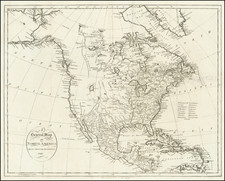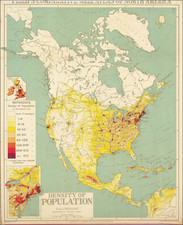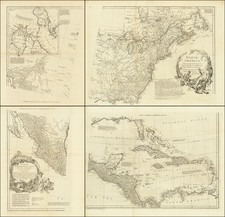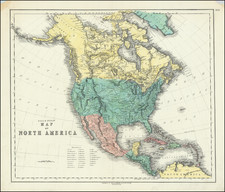Fine depiction of Charles Sprague Sargent's map of the Vegetation of North America, published in 1886 by Petermann.
The map titled Verteilung der Vegetations-Formationen Nord-Amerikas, based on the work of C.S. Sargent, delineates the distribution of vegetation formations across North America. With a scale of 1:25,000,000, this detailed illustration employs color coding to differentiate various forest and prairie regions throughout the continent.
In the legend provided in the bottom left corner, the map categorizes vegetation into four primary types: coniferous forests (Nadelwälder), mixed forests (Gemischter Wald), prairies with less than 20% forest cover (Prairie mit weniger als 20% Wald), and treeless lands with exceptions for riverine areas (Baumloses Land, mit Ausnahme der Flüsse). This classification allows for a clear and systematic representation of North America's diverse vegetation.
Explanations in the bottom right corner of the map include boundaries indicated by red lines, demarcating the Atlantic and Pacific forest regions, as well as subdivisions within these forest zones. The Atlantic Forest Region is further divided into specific provinces: the Northern Atlantic forest province (Nördliche atlantische Waldprovinz), the province of Weymouth pine (Provinz der Weymouths Kiefer), the Southern coastal province (Südliche Küstenprovinz), the deciduous forest of the Mississippi Basin and the Atlantic plains (Sommergrüner Laubwald des Mississippi Beckens und der atlantischen Ebenen), and the subtropical forest (Der halbtropische Wald).
Similarly, the Pacific Forest Region is categorized into the Northern forest province (Nördliche Waldprovinz), coastal forest (Küstenwald), inland forests (Wälder des Binnenlandes), and Mexican forest (Mexikanischer Wald). This comprehensive map not only serves as a crucial historical document reflecting the scientific knowledge and cartographic techniques of the late 19th century but also provides invaluable insight into the distribution and diversity of North American vegetation during that period.
Charles Sprague Sargent
Charles Sprague Sargent (April 24, 1841 – March 22, 1927) was a distinguished American botanist, renowned for his extensive contributions to dendrology and forest conservation. Appointed in 1872 as the first director of Harvard University's Arnold Arboretum in Boston, Massachusetts, Sargent held this position until his death. He published several significant botanical works, and the standard botanical author abbreviation "Sarg." is attributed to plants he identified.
Sargent was the second son of Henrietta (Gray) and Ignatius Sargent, a prosperous Boston merchant and banker who amassed wealth through railroad investments. He was raised on his father's 130-acre estate in Brookline, Massachusetts. He attended Harvard College, graduating in Biology in 1862. Shortly thereafter, Sargent enlisted in the Union Army, serving in Louisiana during the American Civil War and being mustered out in 1865. He subsequently traveled through Europe and Asia for three years.
Returning to the family estate, "Holmlea," Sargent managed it as a horticulturist, influenced by his cousin Henry Winthrop Sargent and H. H. Hunnewell of Wellesley. Under his direction, the estate eschewed flower beds and geometric arrangements in favor of a naturalistic landscape with winding lanes and an abundance of trees and shrubbery. In 1872, upon Harvard's decision to establish an arboretum, Sargent was recommended by Professor Francis Parkman and became the first Director of the Arnold Arboretum, a role he maintained throughout his life. Additionally, he served as Director of the Botanic Garden in Cambridge and was elected to the American Philosophical Society in 1882.
Sargent married Mary Allen Robeson on November 26, 1873, with whom he had two sons and three daughters. One of his daughters married architect Guy Lowell, while his son, Charles S. Sargent, became a partner in a New York securities firm.
Notably, Sargent's later career was marked by his dedication to the Arnold Arboretum, where he collaborated with Frederick Law Olmsted on various projects. Sargent became an influential dendrologist and conservationist, publishing extensively on American forests. He was a member of the National Forest Commission under President Grover Cleveland and was instrumental in advising on the creation of 21 million acres of national forest reserves. Sargent's advocacy for preserving forests in a wilderness state often put him at odds with Gifford Pinchot, who supported sustainable forestry practices.
As a professor of arboriculture at Harvard starting in 1879, Sargent also contributed to the Jesup Collection of North American Woods at the American Museum of Natural History. He was editor and general manager of Garden and Forest from 1888 to 1897 and later the editor-in-chief of the Journal of the Arnold Arboretum starting in 1919. His notable publications include Catalogue of the Forest Trees of North America, Reports on the Forests of North America, and The Silva of North America.
In recognition of his contributions, Sargent was awarded the Veitch Memorial Medal by the Royal Horticultural Society in 1896. The genus Sargentodoxa was named in his honor in 1913 by botanists Alfred Rehder and Ernest Henry Wilson. After his death in 1927, his legacy was commemorated with a white spruce planting at the Massachusetts State House, with the governor acknowledging Sargent's unparalleled knowledge and efforts in tree conservation.
August Heinrich Petermann (1822-1878) is a renowned German cartographer of the nineteenth century. Petermann studied cartography at the Geographical Art-School in Potsdam before traveling to Edinburgh to work with Dr. A. Keith Johnston on an English edition of Berghaus’ Physical Atlas. Two years later he moved to London, where he made maps and advised exploratory expeditions as they set off to explore the interior of Africa and the Arctic.
In 1854, Petermann returned to Germany to be Director of the Geographical Institute of Justus Perthes in Gotha. There, he was the editor of the Geographische Mittheilungen and Stieler’s Handatlas. The Royal Geographical Society of London awarded him their Gold Medal in 1860. He continued his interest in exploration in Germany, fundraising for the German Exploring Expeditions of 1868 and 1869-70, which sought an open Arctic sea. Tragically, he committed suicide in 1878.











![L'Amerique Septentrionale qui fait partie des Indes Occidentales... [with] Description Abrege de L'Amerique Septentrionale](https://storage.googleapis.com/raremaps/img/small/99762.jpg)

![A New Map of North America Shewing its Principal Divisions, Chief Cities, Townes, Rivers, Mountains &c. Dedicated to His Highness William Duke of Gloucester [California as an Island]](https://storage.googleapis.com/raremaps/img/small/100578.jpg)
